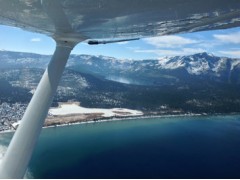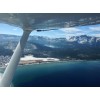Your first step in learning how to fly for pleasure or business is typically obtaining the Private Pilot certificate (which is the correct terminology, some people may refer to it as just a "pilot's license".
Steps involved in becoming a Private Pilot
The general process to obtain your pilot certificate is as follows:
Pass a medical exam - You typically will want to do this early in training (or before you start) to be sure that you don't have any disqualifying medical conditions. Find an AME here.
Start flight and ground training with a flight instructor - You can start ground training first either by self-study, classroom, or one-on-one with an instructor before or in conjunction with your flight training.
Take a knowlege test from your CFI - This will be tailored to your aircraft, local airspace, etc. that is required prior to solo.
Solo - When both you and your CFI feel comfortable about your knowledge and skills, you will receive a sign-off to fly by yourself from the airport you are training at (and fly within a 25nm radius).
Cross country training - You will learn additional skills involved with navigation and flight planning while flying to airports further away.
Take a FAA knowledge test - This test is taken at a designated FAA testing center (PSA or Laser Grade). Although you can take this test any time in your training, you will need a sign-off from a CFI to take the test. A passing grade of 70% is required and the fee is about $150.
Pass your checkride - After completing all the experience requirements, you will prepare and then take your checkride with a FAA designated examiner. This consists of an oral exam and then a flight test portion.
Experience requirements* :
40 hours total time including:
20 hours of dual flight instruction:
3 hours cross country flight training
3 hours night flight training (including a cross country >100 nautical miles and 10 takeoffs/landings to a full stop in the pattern)
3 hours instrument flight training
3 hours dual flight training in preparation for the practical test within the preceding 2 calendar months
10 hours solo flight time, including:
5 hours solo cross-country time (including a cross country >150 nautical miles total distance, full stop landings at 3 points and >50nm between takeoff and landing locations)
3 takeoffs and 3 landings to a full stop (with each landing involving a flight in the traffic pattern) at an airport with an operating control tower.





